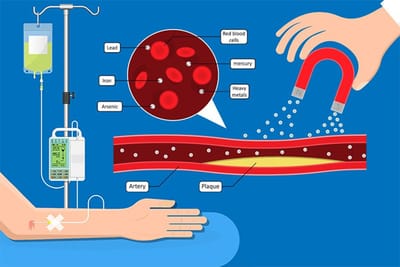Heavy Metals Testing and Treatment


Chelation Therapy is a method for removing heavy metals, such as mercury or lead, from blood. It’s one of the standard treatments for many types of metal poisoning.
How Chelation Therapy: works:
Chelation therapy has been proposed for clearing toxic heavy metals from the body,as it not only removes contaminating metals but also decreases free radical production. The most commonly used chelation agents to date are ethylenediaminetetraacetic acid (EDTA) , dimercaptosuccinic acid (DMSA) and dimecarpol. Some chelators are better at removing certain metals than others are.
Chelators work by binding to metals in the bloodstream. Once they’re injected into the bloodstream, they circulate through the blood, binding to metals. In this way, chelators collect all the heavy metals into a compound that’s filtered through the kidneys and released in urine.
Proven benefits of Chelation Therapy:
Chelation therapy is a very effective way to remove several heavy metals from blood, including:
- Lead
- Arsenic
- Mercury
- Iron
- Copper
- Nickel
- Drinking polluted water
- Breathing heavily polluted air
- Ingesting bits of lead paint
- Wilson’s disease, a genetic disorder that causes copper poisoning in the body
- Hemochromatosis, a condition that causes the body to absorb too much iron from food
- Chronic kidney disease requiring dialysis, which can cause a buildup of aluminum in the body
- Blood disorders, such as thalassemia, requiring frequent blood transfusions, which can cause a buildup of iron in the body
Other benefits of Chelation Therapy
Heart disease:
One large-scale study of chelation for coronary disease has been completed: the Trial to Assess Chelation Therapy (TACT), sponsored by the National Center for Complementary and Integrative Health (NCCIH) and the National Heart, Lung, and Blood Institute.
Overall, chelation therapy produced a reduction in cardiovascular events.
People with diabetes, who made up about one-third of the participants, had a 41 percent overall reduction in the risk of any cardiovascular event; a 40 percent reduction in the risk of death from heart disease, nonfatal stroke, or nonfatal heart attack; a 52 percent reduction in recurrent heart attacks; and a 43 percent reduction in death from any cause over a period of about 5 years.
A large-scale study called Trial to Assess Chelation Therapy 2 (TACT2) is now in progress. Its purpose is to repeat the first TACT study—but only in patients with diabetes who have had a heart attack—to see if the apparent benefit can be confirmed. TACT2 is supported by NCCIH and other NIH agencies.
Diabetes:
Chelation therapy won’t treat diabetes. However, people with diabetes have a much higher risk of developing heart problems. Chelation therapy may reduce this risk. A 2015 subgroup analysis Trusted Source found that EDTA did reduce the risk of heart problems in people with diabetes.
Autism:
A newer NIH study Trusted Source suggests there may be a link between high levels of lead in baby teeth and the development of autism.
Alzheimer’s disease:
The use of chelation therapy for Alzheimer’s disease is based on the data that it linked to buildup of aluminum in the brain from aluminum pots and pans, water, food, and deodorant.
Even most chelators are too large to cross the blood-brain barrier (this barrier acts as a kind of net that controls what enters and exits your brain). However, many researchers found that EDTA may be able to enter the brain.
Parkinson’s disease:
It’s known that iron builds up in the brain of people with Parkinson’s disease. Thus, chelation therapy may be of particular interest for people suffering with Parkinson’s disease and iron excess.
Many people report less pain from chronic inflammatory diseases such as arthritis , lupus , and scleroderma after chelation therapy. The theory is that EDTA acts as an antioxidant, which protects the body from inflammation and protects blood vessels.
How to get Chelation Therapy procedure in our clinic:
Before we proceed with chelation therapy, we need to determine the most suitable chelation agent for you.
For this purpose, we need to check the level of heavy metals in your body via Urine Toxic Metal Test or Hair Toxic Metals Test, or Lead/Aluminum/Mercury in blood serum.
We are, at HHH, use different heavy metals detoxification protocols: with ca-Na- EDTA, DMSA or DMPS.
If your laboratory results support that heavy metals chelation treatment will be beneficial, we will start the treatment.
Our Heavy metals detox protocols also include support for Liver, Kidneys, antioxidants, therapy with binders and enzymes, minerals and vitamins support, which we can add either to your customised IV protocol or as additional oral supplementation – all for your best experience and benefit.
The average duration and frequency for IV heavy metals detox treatment vary from 10 to 40 procedures, with sessions once weekly.
During treatment we will recommend for you to check your Liver/Kidney functional biochemistry tests, electrolytes and minerals in blood serum.
We also will recommend for you to check the amount of heavy metals after the treatment done, or in the middle of the treatment, in order to see and to track the progression of heavy metals being bind and coming out of your body.


